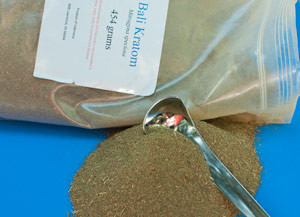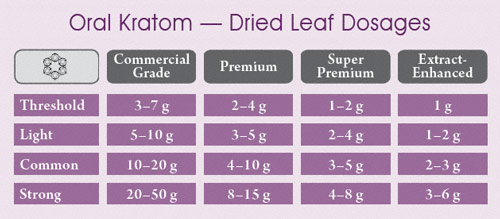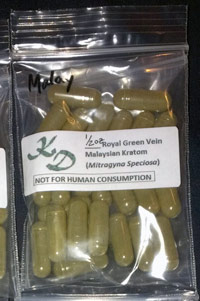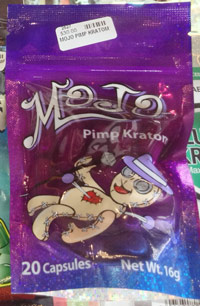On Kratom...
After 15 Years of International Availability
May 2015
Citation: Erowid E, Erowid F. "On Kratom... After 15 Years of International Availability." Erowid Extracts. May 2015;27:12-16.

|
In recent years, we've been asked to write, co-author, and edit several related articles, including a chapter for a 2014 pharmacology textbook titled Kratom and Other Mytragynines: The Chemistry and Pharmacology of Opioids from a Non-Opium Source. For that chapter, we did an informal analysis of more than 700 kratom experience reports and produced a thirty-page description of "The Kratom Experience from Firsthand Reports", outlining the types of effects people experience and the reasons why they use kratom.
We worked with researchers on a more systematic analysis of Erowid's kratom experience reports. This project categorized sentences in Erowid-published kratom reports by theme. Themes were iteratively honed and a short set of "theme codes" developed. Independent readers then validated the theme codes, making sure that each text communicated its identified themes. Largely, this analysis has reinforced the existing experiential literature and Erowid's effects lists and descriptions.
Below is our best current understanding of kratom's use outside of traditional settings, including its dosages and effects, as well as a short retrospective of one person's experiences and a report of an unusual side-effect.
Of the 798 experience reports about Mitragyna speciosa and kratom products that were submitted to Erowid before March 20, 2015, 234 have been accepted by our review team and published. Among submitted reports, 91% were written by men and 9% by women (when author gender was specified). The earliest reports in our collection describe experiences from 2000, which marks the beginning of commercial mail-order availability of kratom in North America, Australia, and Europe.
In 2000, kratom products were generally whole or crushed dried leaf. Based on experience reports and Erowid's vendor monitoring, leaf extracts and extract-enhanced leaf first became available in 2002 and were widely available by 2004. Interest in kratom information grew slowly but steadily during the subsequent decade. In 2004, the Kratom Vault was the 50th most visited substance index on Erowid.org. By early 2014, it had risen to 8th place, but has recently dropped to 15th.
Kratom Use Overview
Generally, in North America, the dried leaves of M. speciosa are taken as a bitter tea, loose-leaf powder, or in capsules. Kratom users commonly describe paradoxically stimulating and sedating effects that are most often likened to the effects of opioids such as codeine or oxycodone. It is used recreationally, as an analgesic, as a self-treatment for opioid withdrawal symptoms, and less commonly as a method for interrupting another addiction (e.g. cigarette or benzodiazepine dependence). Reports from Southeast Asia include significantly more descriptions of chewed (buccal) whole leaves used as a daytime
work drug, taken for the purpose of relieving boredom and the discomfort of manual labor. Kratom is considered addictive; reports of physical and psychological dependence, tolerance, and physical withdrawal symptoms are common, though not universal, in experience reports.Kratom Dosage

|
Retail kratom products available to the general public range from the low potency "commercial grade" crushed leaf, to "premium", "super premium", "enhanced", and "super enhanced" leaf. Extracts are usually labeled as "5x", "15x", or similar, putatively indicating relative strengths. These, plus additional terms such as "Maeng Da" (aka "Pimp Grade"), plant provenance such as "Indonesian", and other vendor-supplied details are used in wine tasting-style comparisons of the quality and potency of products. Although some ethnobotanic a l vendors reliably differentiate weaker from more potent kratom preparations using these terms, other vendors use them as marketing jargon regardless of product potency.
Most kratom used in North America is ingested orally, with a few reports of buccal, smoked, or (more rarely) rectal administration. Many kratom users take repeated doses in a single session/day, often redosing between one to three hours after the previous dose. A day or session of kratom use might involve up to eight doses (see table), though typical usage involves between one and three per day. The dosage estimates above are for single oral administrations in non-habituated users.
Duration
Kratom teas and extracts, when taken orally on an empty stomach, usually begin to take effect within 15 minutes. On the other end of the spectrum, the effects of capsules swallowed on a full stomach can be delayed 1-3 hours. The primary stimulating phase lasts 1-2 hours, with the more sedating effects lasting another 1-3 hours, for a total duration of 2-5 hours for a single oral dose. Higher doses result in longer durations.Users report lingering after-effects lasting several hours before they feel "down" from the experience. Some kratom users report alcohol-like hangovers following moderate or strong doses. Taking kratom daily can result in tolerance and eventually physical dependence. In such instances, symptoms described as similar to those of opioid withdrawal usually begin 18-24 hours after the last dose and continue for 1-14 days.

|

|

|
Effects
The most commonly reported kratom effects range from euphoric stimulation to sleepy dream-like reverie, and from pedestrian caffeine- or alcohol-like intoxication to overwhelming nausea and vertigo. The character of the experience changes as dose increases, beginning with a light relaxing stimulation at low doses and becoming a strong, nodding sedation at high doses. Euphoria and moderate intoxication are characteristic of the mid-dose range.A report of an unusual side-effect:
"VR + Kratom ⇒ Sim Sickness, by RevMeO
A short retrospective of one person's experiences with kratom:
In Praise of Kratom Leaf, by Fer
Positive/Desired Kratom Effects
Simultaneous stimulation and relaxation
Stimulant effects occur earlier and at lower doses, with sedative effects kicking in later and at higher doses. A paradoxical feeling of being both stimulated and sedated at the same time is very common.
Euphoria
Improvements in mood, ranging from mild to gushing euphoria, are common.
Sociability and empathy
Reduced social inhibitions, increased talkativeness, and a sense of enjoying connecting with others are very common. A lasting "glow" In contrast to hangover, some users report feeling better than normal the day following lower-dose kratom use.
Reduction of opioid withdrawal symptoms
Widely used by opioid addicts to mitigate opioid withdrawal symptoms. Sometimes used to wean off, sometimes used as a replacement therapy.
Amelioration of physical labor
Increased physical ease and a reduction in discomfort and boredom during manual labor are described among Southeast Asian field workers and in online reports.
Pro-sexual, aphrodisiac qualities
Some report mildly increased sexuality, eroticism, and prolonged intercourse.
Sleepiness
At higher doses and as time passes, kratom can induce sedation, "nodding", and sleepiness.
Analgesia
Reduction of pain (antinociception), often compared to pharmaceutical opioids, with some saying they prefer the pain relief from kratom.
"Nodding", vivid dreams
At higher doses, opioid-like "nodding" that can include dream imagery; kratom before bed can induce an increase in dreaming.
Stimulant effects occur earlier and at lower doses, with sedative effects kicking in later and at higher doses. A paradoxical feeling of being both stimulated and sedated at the same time is very common.
Euphoria
Improvements in mood, ranging from mild to gushing euphoria, are common.
Sociability and empathy
Reduced social inhibitions, increased talkativeness, and a sense of enjoying connecting with others are very common. A lasting "glow" In contrast to hangover, some users report feeling better than normal the day following lower-dose kratom use.
Reduction of opioid withdrawal symptoms
Widely used by opioid addicts to mitigate opioid withdrawal symptoms. Sometimes used to wean off, sometimes used as a replacement therapy.
Amelioration of physical labor
Increased physical ease and a reduction in discomfort and boredom during manual labor are described among Southeast Asian field workers and in online reports.
Pro-sexual, aphrodisiac qualities
Some report mildly increased sexuality, eroticism, and prolonged intercourse.
Sleepiness
At higher doses and as time passes, kratom can induce sedation, "nodding", and sleepiness.
Analgesia
Reduction of pain (antinociception), often compared to pharmaceutical opioids, with some saying they prefer the pain relief from kratom.
"Nodding", vivid dreams
At higher doses, opioid-like "nodding" that can include dream imagery; kratom before bed can induce an increase in dreaming.
Neutral Kratom Effects
Pupil pinning/miosis
As with most mu-opioid agonist drugs, pupils decrease in size and responsiveness as a function of dose.
Change in ability to focus eyes
People report unexpected shifts in focal ranges, speed, and precision.
As with most mu-opioid agonist drugs, pupils decrease in size and responsiveness as a function of dose.
Change in ability to focus eyes
People report unexpected shifts in focal ranges, speed, and precision.
Negative/Unwanted Kratom Effects
Difficulty consuming as tea
Kratom's bitter, grassy taste and resistance to colloidal suspension can make it unpleasant to consume for novices.
Itchiness / pruritus
Itchiness similar to that experienced from opioids is common, with a small number of reports describing pruritus continuing for days after last use.
Mild depression during or after
Although uncommon, some report dysphoria or depressed mood either during or in the days following use.
Tolerance
The same dose of kratom diminishes in effectiveness over consecutive days of use. Perceived increase in body temperature Some report feeling hot and sweaty while effects start, at the peak, and/or while coming down.
Reduced sexual desire or performance
Some users describe decreased sexual desire, interest, and performance.
Dizziness, nausea, and vomiting
At higher doses or when used in combination with alcohol, benzodiazepines, or opioids; nausea, vertigo, and vomiting are common.
Hangover similar to alcohol
Next-day and hangover effects range from feeling better than normal, to mild alcohol-type hangovers, to more serious nausea and dysphoria.
Desire to repeat use more often than intended
Some users report thinking about taking kratom and desiring to take kratom more often than they would choose to.
Addiction, difficulty controlling use, and withdrawal symptoms
As with other opioid-agonist drugs, kratom use leads to tolerance, desire to redose, and withdrawal effects after daily use.
Liver health problems
Inflammation of the liver (hepatitis) and symptoms of hepatotoxicity are described in a small number of cases, though it is unknown whether these are due to kratom itself or product contaminants.
Kratom's bitter, grassy taste and resistance to colloidal suspension can make it unpleasant to consume for novices.
Itchiness / pruritus
Itchiness similar to that experienced from opioids is common, with a small number of reports describing pruritus continuing for days after last use.
Mild depression during or after
Although uncommon, some report dysphoria or depressed mood either during or in the days following use.
Tolerance
The same dose of kratom diminishes in effectiveness over consecutive days of use. Perceived increase in body temperature Some report feeling hot and sweaty while effects start, at the peak, and/or while coming down.
Reduced sexual desire or performance
Some users describe decreased sexual desire, interest, and performance.
Dizziness, nausea, and vomiting
At higher doses or when used in combination with alcohol, benzodiazepines, or opioids; nausea, vertigo, and vomiting are common.
Hangover similar to alcohol
Next-day and hangover effects range from feeling better than normal, to mild alcohol-type hangovers, to more serious nausea and dysphoria.
Desire to repeat use more often than intended
Some users report thinking about taking kratom and desiring to take kratom more often than they would choose to.
Addiction, difficulty controlling use, and withdrawal symptoms
As with other opioid-agonist drugs, kratom use leads to tolerance, desire to redose, and withdrawal effects after daily use.
Liver health problems
Inflammation of the liver (hepatitis) and symptoms of hepatotoxicity are described in a small number of cases, though it is unknown whether these are due to kratom itself or product contaminants.
2015 and Beyond
Kratom is one of those psychoactives that occupies a curious position as a traditional plant medicine with real potential for pharmaceutical development, naturopathic healing, and addiction management uses. It parallels cannabis or khat in the global apothecary, along with attendant complexities of an extended ethnobotanical history, cultural expectations, and social resistance to allowing another natural intoxicant to creep into widespread use.Vendors contacted by Erowid between 2013 and 2015 described ceasing kratom sales because of concerns about federal and state law enforcement, news coverage, and legislative threats. Some vendors stopped listing the products (but continued to sell them privately) to avoid attention, while most have stopped selling kratom completely.
Kratom's opioid-like analgesia and the possibility that it might be less likely to lead to problematic addiction make it a potentially important plant medication. But, as far as establishment medicine goes, it faces the same challenge as opioids: it is kind of fun for many users. Two years ago, kratom seemed headed for quick bans across the United States, but it has gained some support from medical research communities and has so far stayed out of the federal Schedules. Kratom pokes yet another hole in the poorly-conceived US Controlled Substances Act and UN Convention on Psychotropic Substances: There must be a place for natural plant products with real medicinal value outside of the black market.
Revision History #
- v1.0 - May 2015 - published in Erowid Extracts.
- v1.01 - Jan 2016 - Erowid - Published on Erowid.org. Tense change in third paragraph to reflect completion of analysis of Erowid's kratom experience reports, published Nov 2015 in Journal of Psychoactive Drugs.

